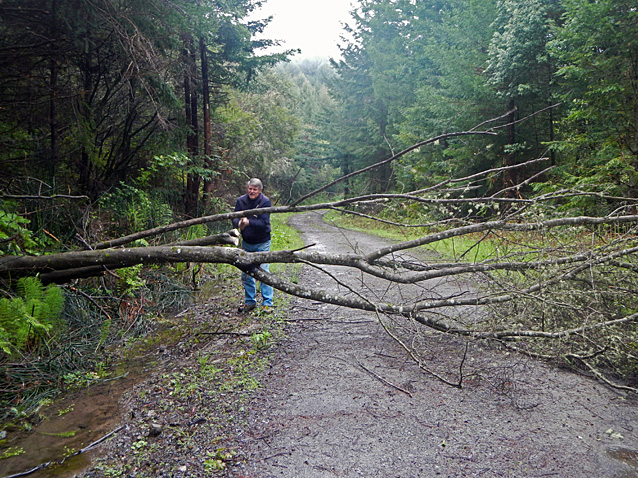 |
Sonoma tree vole diorama, Photographer Gabriel Moulin,
courtesy California Academy of Sciences Archives. |
Fifty years ago the red tree mouse diorama at the California Academy of Sciences looked like this*.
Periodically I would visit and stand there spellbound.
Like the
mossy gym sock exhibited in the same hall, the tree mouse diorama featured an intriguing nest with red-haired mice disporting themselves like sugar plum fairies.
I knew that some day I would find one of those nests. I was certain that I would know one when I saw it.
Little did I know a half century stood between my youthful ambition and its realization, but faithful readers of this blog already know the codger encountered his
first red tree vole a couple months ago.
It was a fleeting engagement and not particularly satisfying.
The nest was a pathetic example of mouse work, a paltry accumulation of fir needles balanced over a recess in the trunk, and the resident's activities were usually out of the camera's view.
I needed to find a brood nest like the one above -- an overstuffed cushion of fur needles, a spacious stage where a mother vole performs her nocturnal ritual and little voles play in the moonlight.
A week ago we resumed the search and wandered the logging roads with slack-jaws and craned necks looking like crazed birders.
Nests we found, and some were even in climbable trees, but all were beyond reach unless you had a cherry picker or a very well-trained monkey.
 |
They looked like tree vole nests, but only a fool
or a monkey would climb them to find out. |

The afternoon was wearing on and I was ready to admit defeat when we wandered off the road into a young stand of Douglas fir, and there it was about 35 feet above us -- a messy tangle of sticks and fir needles right next to the trunk.
 |
| Fresh clippings and resin ducts told us the nest was occupied. |
It was an excellent climbing tree with whorls of reasonably stout limbs -- living limbs mind you, not the rotten ones so common on older trees. Terry fetched the ladder while I admired the tree and yammered about its suitability.
My first ascent convinced me that the climbing path needed a haircut. So dense were the springy wire-like twigs that I felt like a Lilliputian climbing a wire chimney brush.
That done, I drilled a hole in the limb and screwed in a lag bolt mount.
The camera was a HD video cam -- a DXG 567v with a small IR array home-brewed by the talented camera hacker "EgbertDavis" .
I dropped the camera stem into the mount, adjusted the camera angle, opened the back one last time, and powered it up.
Having tested the camera on wood rats last fall, I knew the infra-red illumination wouldn't bleach the subjects at close range.
Terry and I made 5 camera trap sets that day, but this was the set that haunted my reverie as I drove up the Trinity River Canyon on my way home.
Then the car radio lost its reception and disturbing thoughts started to seep in.
Had I tightened the wing nut enough to maintain the camera angle? Would the wind buffet the camera, cause false triggers, and fill the SD card with useless footage? And how long would the batteries last?
Two nights later a big storm blew in off the Pacific.
I emailed Terry: "We've been getting heavy winds and rain, and
I'm a little worried about that cam in the Doug fir. Hopefully it is sitting tight".
"We had wind gusts up to 40 mph", he answered "and last night got a big hail storm which lasted about 10 minutes".
I envisioned the fir's limbs whipping furiously in the storm, and then I saw the distressing aftermath -- a heap of broken boughs and my DXG lying on the ground.
Manic expectation, doubt, worry, disillusion, chagrin, and finally the blues -- this is the emotional roller-coaster called camera trapping.
As for the haunting doubt and worry -- I guess you can call it Post-Set-Anxiety Syndrome.
+++++ +++++ +++++
*/ Of course, the wire mesh and support structure wasn't visible; the photo must have been taken when they demolished the exhibit.


















